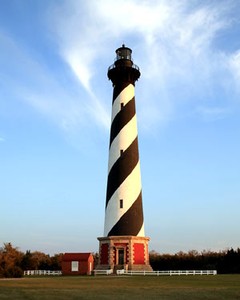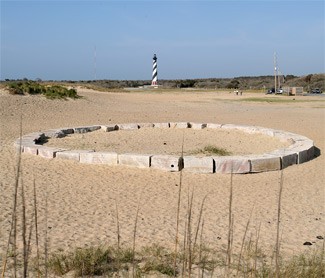Cape Hatteras Lighthouse
Introduction
Text-to-speech Audio
Soaring 198 feet in the air on shore of the Outer Banks is Cape Hatteras Lighthouse, the tallest brick lighthouse in North America and second tallest in the world. Completed in 1870, this is the second lighthouse to stand at Cape Hatteras; the first was completed in 1803 and demolished in 1871 for not fully meeting the needs of the area. The ever-changing sandy shoals off the coast of Cape Hatteras are among the most dangerous and unpredictable on the Atlantic Coast, causing countless shipwrecks and giving the area the nickname "The Graveyard of the Atlantic." Cape Hatteras Lighthouse served mariners with its distinctive Black-and-white spiral daymark and flashing beacon, powered by a kerosene flame and reflected into the ocean with a glass Fresnel lens (now replaced with an electric light). The lighthouse was decommissioned in 1935 and transferred from the Bureau of Lighthouses (later dissolved into the U.S. Coast Guard) to the National Park Service in 1937. In 1999, the lighthouse was moved 2,900 feet from its original location on the quickly-eroding coast. Today, visitors can climb the 269 steps to the top of the lighthouse and enjoy a view of Cape Hatteras National Seashore, along with touring the Keepers Quarters, which have been converted into museums.
Images
Current Location of the lighthouse

Old location

Backstory and Context
Text-to-speech Audio
Prior to modern navigation, lighthouses were a primary method of identifying dangerous coasts. The waters off Cape Hatteras were especially hazardous. The Atlantic Coast consists of two primary currents, the warm Gulf Stream heading north and the cool Labrador Current heading south. These currents meet at Cape Hatteras, creating perfect conditions for powerful storms, sea swells, and constantly-changing sandbars. These unpredictable, underwater sandbars, known as the Diamond Shoals, extend for miles off the coast of Cape Hatteras and are responsible for thousands of shipwrecks. One famous ship that sank in this location was the Civil War ironclad USS Monitor. The deaths of countless travelers earned this coast the nickname, "The Graveyard of the Atlantic."
Lighthouses in the United States were authorized by various government agencies over time, including the Treasury Department's Lighthouse Establishment (1791-1851), the United States Lighthouse Board (1852–1910), the United States Lighthouse Service (1910–1939) and the United States Coast Guard (since 1939). These agencies also worked with the U.S Army Corps of Engineers, the U.S. Navy, the U.S. Coast Survey, and the Smithsonian Institution to ensure lighthouses were properly built and maintained. Congress authorized the first lighthouse at Cape Hatteras in 1794. Construction was completed in 1803, though this short structure with a weak beacon was inadequate for the Cape's dangerous waters. In 1853, another 60 feet was added to the height of the lighthouse and the brick painted with a red and white daymark. While this lighthouse was more successful, a growing list of repairs led the Lighthouse Board to plan for a new lighthouse.
Construction on the second lighthouse began in October 1868 and the new beacon was lit on December 1, 1870. The new lighthouse, the one that stands today, was 198 feet tall and painted with a Black-and-white spiral daymark. The light, or "lamp," at the top of the lighthouse was originally fueled by whale oil and then by kerosene. The lighthouse used a first order Fresnel lens to project the light 20 miles into the ocean, the most powerful of its kind. The lens, consisting of a series of stacked prisms, was first installed in the old lighthouse in 1854 and transferred to the new one upon its completion.
To maintain the lighthouse, the Lighthouse Board stationed a Principal Keeper and two Assistant Keepers at Cape Hatteras. They lived with their families in houses that have now been converted into museums. The lighthouse keepers performed a variety of jobs, including operation of the lighthouse, administrative duties, and maintenance. Each keeper stood a four-hour watch at night, alternating shifts daily. While on duty, keepers lit and maintained the lamp, carried fuel up the spiral staircase, and monitored shipping activities. While the lamp was not lit during the day, the keepers' work continued. They regularly cleaned the lens and windows of the lantern room, which became smoky from the lamp burning all night, every night. The lens used a clock-like system of mechanics to turn, which also needed cleaned, lubricated, and cranked. Additionally, lighthouse keepers conducted maintenance such as painting and basic repairs, wrote reports, ordered supplies, and hosted visitors.
Lighthouses in the United States were authorized by various government agencies over time, including the Treasury Department's Lighthouse Establishment (1791-1851), the United States Lighthouse Board (1852–1910), the United States Lighthouse Service (1910–1939) and the United States Coast Guard (since 1939). These agencies also worked with the U.S Army Corps of Engineers, the U.S. Navy, the U.S. Coast Survey, and the Smithsonian Institution to ensure lighthouses were properly built and maintained. Congress authorized the first lighthouse at Cape Hatteras in 1794. Construction was completed in 1803, though this short structure with a weak beacon was inadequate for the Cape's dangerous waters. In 1853, another 60 feet was added to the height of the lighthouse and the brick painted with a red and white daymark. While this lighthouse was more successful, a growing list of repairs led the Lighthouse Board to plan for a new lighthouse.
Construction on the second lighthouse began in October 1868 and the new beacon was lit on December 1, 1870. The new lighthouse, the one that stands today, was 198 feet tall and painted with a Black-and-white spiral daymark. The light, or "lamp," at the top of the lighthouse was originally fueled by whale oil and then by kerosene. The lighthouse used a first order Fresnel lens to project the light 20 miles into the ocean, the most powerful of its kind. The lens, consisting of a series of stacked prisms, was first installed in the old lighthouse in 1854 and transferred to the new one upon its completion.
To maintain the lighthouse, the Lighthouse Board stationed a Principal Keeper and two Assistant Keepers at Cape Hatteras. They lived with their families in houses that have now been converted into museums. The lighthouse keepers performed a variety of jobs, including operation of the lighthouse, administrative duties, and maintenance. Each keeper stood a four-hour watch at night, alternating shifts daily. While on duty, keepers lit and maintained the lamp, carried fuel up the spiral staircase, and monitored shipping activities. While the lamp was not lit during the day, the keepers' work continued. They regularly cleaned the lens and windows of the lantern room, which became smoky from the lamp burning all night, every night. The lens used a clock-like system of mechanics to turn, which also needed cleaned, lubricated, and cranked. Additionally, lighthouse keepers conducted maintenance such as painting and basic repairs, wrote reports, ordered supplies, and hosted visitors.
As the twentieth century progressed, new technologies supplemented and replaced the need of traditional lighthouses. The Lighthouse Service replaced the vandalized Fresnel lens with a modern aero beacon in 1934, yet chose to decommission the brick tower the following year. The aero beacon was temporarily moved to a steel tower until 1950, when it returned to the original lighthouse. The present beacon was installed in 1972 and flashes every 7.2 seconds.
Like many historic structures that fell out of use, the Cape Hatteras Lighthouse and its surrounding property were turned over to the National Park Service in 1937 as part of Cape Hatteras National Seashore, stretching 70 miles along Hatteras Island, Bodie Island, and Ocracoke Island. As the Outer Banks became an increasingly popular vacation spot, Cape Hatteras Lighthouse, along with other lighthouses, historic life-saving stations, and the Wright Brothers Memorial, became a top tourist destination. In the New Deal era, the Civilian Conservation Corps offered tours of the lighthouse, maintained the property, and began protecting the lighthouse from the encroaching sea. During World War II, with German U-boats lurking in the waters, the U.S. Coast Guard used the lighthouse as an observation tower.
Cape Hatteras Lighthouse made history again 1999, when it was moved 2,900 feet from its original location. The shores of Hatteras Island, essentially a large sandbar, is constantly changing. Erosion of the shore, along with rising sea levels, caused the water to creep closer to the lighthouse. In 1975, the water was 175 feet away; by 1980, the water was only 50 to 70 feet away. After years of saving mariners, now the lighthouse needed to be saved. Studies recommended moving the lighthouse to ensure its longevity. The International Chimney Corporation of Buffalo, New York, contracted by the National Park Service, completed the largest relocation of such a structure in history. The lighthouse was lifted from its original location on June 17, 1999 and a system of hydraulic jacks and rollers finished shifting the lighthouse to its current location on July 9, 1999.
Sources
National Park Service. "Cape Hatteras Light Station." Cape Hatteras National Seashore. Last updated April 14, 2015. Accessed August 2018. https://www.nps.gov/caha/planyourvisit/chls.htm
National Park Service. "The Lightkeepers." Cape Hatteras National Seashore. Last updated October 27, 2017. Accessed August 2018. https://www.nps.gov/caha/learn/historyculture/lightkeepers.htm
National Park Service. "The Lightkeepers." Cape Hatteras National Seashore. Last updated October 27, 2017. Accessed August 2018. https://www.nps.gov/caha/learn/historyculture/lightkeepers.htm
